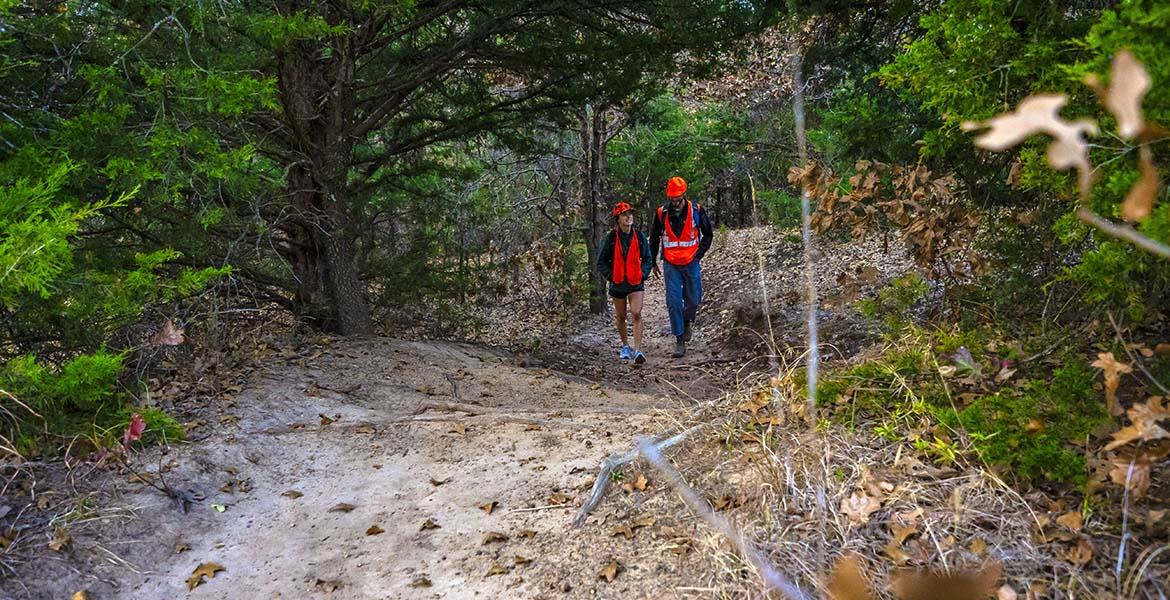
Hikers: Be careful during deer hunting season
Tuesday, November 17, 2020
For many nature-lovers, hiking through the woods on a crisp fall day is a great opportunity for exercise and fresh air. However, this time of year also is a favorite of deer hunters. With rifle season opening Nov. 21, both hikers and hunters must use caution.
Emily Long, Payne County game warden, said hunting activity is at its peak during the weekends. She urges bright colors and careful scheduling.
“If you want to get out in the woods to hike, it’s a good idea to wear a blaze orange beanie or even a safety vest to help make your presence known,” Long said. “Hunting takes place in the early morning and late afternoon/early evening, so hikers are less likely to encounter hunters if they’re out for a hike during mid-day.”
Long also said hikers need to be aware they cannot hike on private property without landowner permission, and wildlife management areas across the state are closed to non-hunters.
Dwayne Elmore, Oklahoma State University Extension wildlife specialist, professor and Bollenbach Chair in OSU’s Department of Natural Resource Ecology and Management, said it is a good idea for hikers to stay in open areas as much as possible.
“If you’re out walking around in areas where hunters are looking for deer, it’s important for you to be seen clearly by the hunters,” he said.
In addition to hikers practicing safety, hunters also have safety guidelines they should follow. Avid hunters are eager to get out in the wild, and they often are bringing along a second- or third-generation hunter. To help ensure safety, youngsters are encouraged to complete the Hunter Education program offered through the Oklahoma Department of Wildlife and Conservation.
Those who hunt from an elevated stand should wear safety harnesses. Elmore said about 75% of hunting accidents occur when climbing in and out of those stands.
“Always wear a fall-restraint harness when hunting from an elevated stand,” he said. “Many accidents occur before hunting season when people are simply checking on their stands or putting out deer attractant, and are not prepared with a restraint.”
It is not just deer hunters in tree stands who should take safety precautions. Elmore said waterfowl hunters always should wear a personal flotation device (PFD) while on the water.
Sometimes hunters ignore this precaution because they are already wearing bulky clothing. However, this is all the more reason to wear a PFD.
“Bulky clothing and icy cold water aren’t a good mix. Even an experienced swimmer doesn’t have the odds in their favor of making it to safety if they become submerged,” he said. “Waders can quickly fill with water pulling the person under.”
He suggested cinching the top of waders tightly to minimize water intake or wear tighter fitting neoprene waders.
Hunters need to look well beyond their targets also. Before shooting, hunters should be sure the animal is in full view with a clear backstop. Bird hunters are particularly at risk of badly aimed firearms, as they tend to hunt in groups in dense cover for fast moving birds going in random directions.
“Make sure you know where your entire hunting party is at all times, avoid shooting at low birds, and wear an orange hat as that may be the only part of you above tall cover,” Elmore said.
An additional safety precaution is to always tell someone where you are hunting and what time to expect you home. If something happens, that person will know where to send assistance.
For those fortunate enough to bag a deer or waterfowl, exercise caution when cleaning and processing game. Elmore suggests wearing disposable gloves and eye protection to help prevent infection from zoonotic diseases. When processing, use a sharp knife and never cut toward your body. Also, be sure to check for ticks after handling dead game.
A few safety precautions can go a long way in ensuring a safe and successful hunting season.
Long said anyone with questions regarding hunting laws and regulations should contact their local game warden via the game warden directory at the Oklahoma Department of Wildlife and Conservation.
More hunting and safety tips are highlighted on OSU Extension’s SUNUP television program.
MEDIA CONTACT: Trisha Gedon | Agricultural Communications Services | 405-744-3625 | trisha.gedon@okstate.edu
